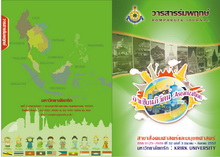การสื่อสารทางการเมืองในประชาคมอาเซียน
Main Article Content
Abstract
บทความนี้ทำการศึกษากระบวนการสื่อสารทางการเมืองของ 10 ประเทศในประชาคมอาเซียน ผ่านกรอบแนวคิดทฤษฎีบรรทัดฐานของสื่อมวลชน ที่มองว่าเสรีภาพของสื่อมวลชนเป็นเหมือนกระจกเงา ที่สะท้อนเสรีภาพของประชาชน โดย ทฤษฎีนี้แบ่งประเภทของสื่อมวลชนตามสิทธิและเสรีภาพในการแสดงออก เป็น 4 ประเภทคือ ทฤษฎีเสรีนิยม (Libertarian Theory) ที่เชื่อว่าเสรีภาพเป็นสิทธิขั้นพื้นฐานของประชาชน ดังนั้นสื่อมวลชนจึงมีเสรีภาพในการวิพากษ์วิจารณ์ รัฐบาลได้ ซึ่งประเทศที่จัดอยู่ในทฤษฎีนี้คือ บรูไน ไทย และอินโดนีเซีย
ทฤษฎีความรับผิดชอบต่อสังคม (Social Responsibility Theory) เป็นทฤษฎีที่เน้นให้สื่อมวลชนตระหนักถึงความรับผิดชอบต่อสังคม โดยมี มาเลเซีย ฟิลิปปินส์ และสิงคโปร์ ที่ใช้การสื่อสารทางการเมืองในขอบเขตนี้
ทฤษฎีอำนาจนิยม (Authoritarian Theory) เป็นทฤษฎีที่รัฐมีอำนาจเหนือสื่อมวลชน รัฐใช้สื่อเป็นเครื่องมือในการสื่อสารทางการเมืองกับประชาชนในชาติและนานาชาติ โดยสื่อจะถูกจำกัดสิทธิ์ในการวิพากษ์วิจารณ์รัฐ ประเทศที่อยู่ในกลุ่มนี้ ได้แก่ เมียนมาร์และกัมพูชา
ทฤษฎีเบ็ดเสร็จนิยม (Totalitarian Theory) เป็นวิถีทางของประเทศที่ใช้ระบอบสังคมนิยมคอมมิวนิสต์ในการปกครอง ได้แก่ ลาวและเวียดนาม ซึ่งพรรคคอมมิวนิสต์ของประเทศเหล่านี้จะควบคุมกลไกการสื่อสารให้ตอบสนองต่อแนวทาง ของรัฐเท่านั้นความแตกต่างหลากหลายในกระบวนการสื่อสารทางการเมืองของประชาคมอาเซียน ไม่เพียงแต่เรื่องของภาษา แต่รวมถึงวัฒนธรรมทางสังคม สิทธิเสรีภาพทางการเมือง ซึ่งการหลอมรวมเป็นหนึ่งเดียว จำเป็นที่ทุกประเทศจะต้องปรับตัว และแสวงหาจุดร่วมเพื่อสร้างเอกภาพในการสื่อสารทางการเมืองในภูมิภาคนี้
Political Communication in ASEAN Community
The ASEAN community is united under the three pillars, which are: political- security, economic prosperity and the socio - culture. This co-operation does not only require a universal language of communication, which is English, but also the know-how of effective political communication between countries in order to sustain this coalition.
This article will explore the means of political communication of 10 countries in the ASEAN community within the framework of the Theory of the Norms of The Media, where the states that the degree of freedom of the media reflects the degree of freedom of the population in a given country. This theory categorizes the said degree freedom of the media and expression into 4 categories:
1. Libertarian Theory, which states that the nation recognizes the basic rights of its population, thus the media is free to critique the government at will. The countries that would fall in to this category are Thailand, Indonesia and Brunei.
2. Social Responsibility Theory, which states that the media should recognize its responsibility to the society and should act accordingly. Medias of Malaysia, The Philippines and Singapore adhere to this theory.
3. Authoritarian Theory states that the state has power over the media and utilizes it as a means of communication with its citizens and the world. Therefore the media could not criticize government in any way. Myanmar and Cambodia would satisfy the criterion of this category.
4. Totalitarian Theory states that in communist states such as Laos and Vietnam, the government controls the media and the media only answers to the state control.
Language alone does not account for the variety of means of political communication in nations of the ASEAN community but also culture and the degree of political freedom. In order to become one, the nations of ASEAN must adapt and find a point of compromise in their methods of political communication to foster unity in this international community.
Article Details
Every article published in the Romphruek Journal of the Humanities and Social Sciences is the opinion and point of view of the authors. Thery're not the viewpoint of Krirk University or the editored department. Any part or all of the articles for pablication must be clearly cited.


